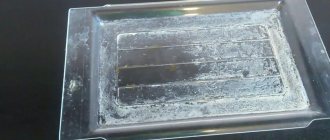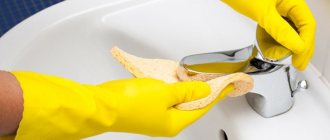The appearance of limescale on the surface of the sink is caused by the evaporation of moisture. Since it contains heavy salts and other impurities, when dried, they remain on the coating and are deeply eaten if they are not removed in a timely manner. This problem should not be ignored, as it can result in faucet malfunctions and loss of aesthetics of plumbing fixtures. In this article we will tell you in detail what to do if limescale does appear on the sink, as well as how to prevent its formation.
Plaque in a stainless steel sink Source waysi.ru
Where does plaque appear on surfaces and what does it mean?
Any surface, be it iron, plastic, glass, ceramics, stainless steel and others, when constantly in contact with water, necessarily begins to acquire a whitish coating: these are salts and limestones.
Thus, if, after condensation has accumulated on the surface of the sink and its components, you do not wipe them dry, then over time you will notice whitish stains. Continuing to ignore this problem, plaque accumulates and becomes more pronounced. In such situations, getting rid of it is much more difficult.
The ingress of foam from shampoo, soap, toothpaste and other personal hygiene products is also accompanied by the appearance of such deposits. Therefore, it is extremely important to rinse surfaces after showering or washing and, if possible, wipe dry.
Limescale deposits in the sink and on the faucet Source severdv.ru
The formation of deposits can cause the following problems:
- violation of the tightness of seals on mixers and connecting fittings;
- reduction of heat transfer on high-temperature elements (if a mixer with a heater is installed);
- the service life of moving parts of the faucet and sink fittings is reduced;
- the condition of the enamel deteriorates, and in the future even its upper layers are destroyed;
- it is possible that the opening in the faucet may narrow.
Accordingly, the appearance of limescale must be combated immediately, even after the formation of a small number of deposits.
White spots on a metal sink Source ratatum.com
Final tips
It is easier to prevent any problem than to fix it. To avoid the hassle of labor-intensive thorough cleaning of your sink, do the following every day:
- After washing large volumes of greasy dishes, rinse the sides of the sink with a degreaser.
- Dried water stains lead to the formation of limescale. Therefore, make it a rule to wipe the sink with an absorbent cloth every time after use.
- If you see a newly appeared stain, it is better to remove it as quickly as possible using starch, soda, vinegar, or bleach.
- Rubbing with wax or olive oil will add shine to the sink.
- To get rid of dried water stains, treat the surface with glass cleaning liquid.
- Soaking dishes in the sink will quickly dirty the sink.
Cleaning a sink - stone, enameled, ceramic, cast iron or stainless steel - is not such a difficult task if you know which products are most effective for a given case. And also - take care of the sink every day and do not put off its thorough cleaning for a long time “later”.
Quick ways to clean stains on your sink
When the formation of white deposits on parts of the sink has just begun to be seen, quick methods using products that can be found on the farm will help to cope with the problem:
- Pour pure table vinegar into a spray bottle or spray bottle, apply it through the dispenser onto the dirt and leave for 15 minutes to soak. Then brush with an old toothbrush and rinse with water. Wipe dry.
- If you see a yellow stain around the faucet, take one packet of citric acid and pour this powder under the base of the faucet. Leave on for ten minutes and rinse with warm water. Make sure that no crystals of the product remain, because they can become a point of accumulation of plaque.
- When old limestone appears on the inside walls of the sink or on the drain hole, close the latter with a stopper and fill the sink with warm water. Then pour 250 ml of table vinegar there and leave overnight. In the morning, simply drain the water and rinse the container.
- Remove dried soap marks on the surface with ammonia. To do this, pour hot water into any container and add a tablespoon of ammonia. Dampen a microfiber cloth or clean rag with this solution and wipe the sink surfaces generously. Leave for 10 minutes then rinse with water.
Cleaning the sink from plaque in a quick way Source felipeberontatt.com
Cleaning a stone sink
Cleaning sinks made of artificial stone prohibits the use of:
- Abrasive type powders;
- Detergents containing acid, alkali, acetone;
- Washcloths and sponges with a rough structure.
Some cleaning products are not suitable for stone sinks
The following professional cleaning products are suitable for artificial stone units: Mister Chister, Acrylic Polish, Ravak Cleaner.
Using professional products
Conventionally, all professional means for combating different types of plaque in the bathroom are usually divided into three groups.
Abrasive
These are preparations that contain grains of powder. The larger these particles, the more aggressive the composition is. Usually the active ingredients are sand, soda, borax, pumice, etc. The main disadvantage of using such compounds is the appearance of deep scratches on the surface being cleaned. It is strictly forbidden to use these chemicals to remove plaque from nickel-plated, aluminum, and copper parts. The means of this group include:
- Comet in powder form;
- Sorti;
- Pemo-Lux (soda);
- Chistin;
- Sarma;
- Biolan.
Only ceramic coatings should be cleaned with such products, and formulations with only fine powder should be used. Moreover, friction to clean plaque should be carried out with weak, barely pressing movements.
Rinsing the sink after using chemicals Source jadoma.ru
Alkaline
Such compositions help to quickly rid the surface of the sink of any type of plaque. Typically, these drugs include drugs whose main component is sodium hydroxide (for example, sodium hydroxide). The composition is applied to the deposit and left for 10-15 minutes. It is important not to leave it on the defect and have time to remove it after the specified time. Such drugs include:
- MULTILUX;
- Domes;
- Chistin;
- Help;
- Pemoxol.
The cleaning procedure using alkaline preparations is repeated only when strictly necessary. For example, if the plaque is very ingrained.
How to remove plaque from plastic
It is more difficult to wipe off water stains on a plastic sink than to wash a product made of ceramics, metal or glass. Here are a few universal folk remedies that allow you to cope with almost any plastic contamination:
- Soda paste. The product is prepared from ordinary soda and warm water. Apply the paste with a sponge to the contaminated area and leave for 2-3 hours. Wash off with warm water. Before using this method, it is worth considering that soda paste is good for matte surfaces, but can leave scratches on glossy ones.
- Alcohol. The liquid is diluted with water one to one and applied locally to contaminated areas. It is not advisable to use alcohol on colored surfaces, as whitish spots may form.
- Ammonia. One tablespoon of ammonia is diluted in 1 liter of water, applied to the sink using a spray bottle, then washed off with water. This product is also good for cleaning plastic window frames.
- Household chemicals. Gentle detergents (e.g. Cif cream, LOK cleaner, Glorix spray) are also suitable for cleaning limescale from plastic. The main thing is to follow the instructions and wait the exact time before rinsing off.
Video description
How to clean limescale on faucets and plumbing fixtures. How to clean a faucet until it shines without effort.
Acidic
The use of acid-based cleaning products is effective even if limescale or soap deposits have formed long ago and have had time to harden on the surface. But you must remember that acid negatively affects not only the deposits themselves, but also the protective layer of the sink and its fittings.
Such agents usually include boric, citric, and ascorbic acid in their pure form. Less commonly, they are found in cleaning powder chemicals.
Using acidic preparations to clean the sink Source jadoma.ru
Conclusion
If your sink has lost its shine and is covered with plaque, do not rush to run for expensive advertised products. At home, you can prepare equally effective solutions, the use of which gives excellent results (see also the article “How to clean an artificial stone sink and features of caring for it”).
The video in this article will help you learn how to prepare such products and methods for cleaning plumbing fixtures.
Did you like the article? Subscribe to our Yandex.Zen channel
Folk remedies
Cleaning the sink can also be done using folk remedies. The following compositions will help get rid of even old traces of lime and soap:
- Soda and vinegar. Wet the problem area and then sprinkle some baking soda on it. Using a spray bottle, apply table vinegar on top. Wait until the hissing reaction is over, wipe off any remaining product and plaque, and rinse with clean water.
- Lemon juice. Squeeze the juice from a fresh lemon onto the dirt and wipe with a cloth soaked in warm water. You can even leave such a napkin on the surface with a coating for half an hour. Afterwards, rinse with water.
- Mustard powder. Take two tablespoons of the product and soak in a little water. Use the prepared gruel to clean stains on the surface of the sink. Cleans soap, lime and rust deposits.
Folk remedies can ideally clean only recently formed stains.
Removing plaque from sink drains using folk remedies Source onegyre.ru
Lemon – protection against small stains
You can deal with waterstone deposits that have recently appeared using lemon juice. To do this, just rub the areas contaminated with plaque with a slice of lemon, leave for half an hour, then rinse with water and wipe with a dry cloth.
Features of cleaning sinks from plaque depending on the material of manufacture
Sinks can be made from various materials, and accordingly, cleaning plaque from surfaces will involve the use of specific compositions. We suggest you look into these nuances.
Stainless steel sink
Stainless steel plumbing fixtures are often used in the kitchen. To clean deposits on such a surface, you can use powdered chemicals from the store, use soda ash or baking soda. Simply sprinkle the dirt with powder and leave for a few minutes, then rub the area with a damp foam sponge.
If, over time, dark spots appear in places where limescale deposits are located, then vinegar, hydrogen peroxide, starch, and Coca-Cola will help deal with them. A sponge or any cloth is moistened with these products, after which all areas are thoroughly wiped. Using the listed products will restore the shine to the product.
Cleaning a stainless steel sink in the kitchen Source openoblokah.ru
Enameled
It is prohibited to use any abrasive compounds to clean enamel sinks. They leave scratches into which dirt penetrates and begins to adversely affect the structure of the material from the inside. Removing defects is best done with 9% vinegar and soda. There are also a large number of special household chemicals designed specifically for enamel coatings. They are mainly made in the form of a paste or gel.
Remember! When cleaning an enamel-coated sink, you should treat not only the problem areas, but the entire surface. Since stains from chemicals may appear.
Ceramics and stone
Such sinks are the most popular and can be cleaned with professional products such as Cilit, Сomet, Domestos and other gel-based compounds. For ceramics, it is even allowed to use preparations to clean toilet bowls.
Regarding stone plumbing fixtures. It is highly undesirable to experiment with cleaning methods, since these coatings are capricious. Ideally, to remove plaque, use dish gels Fairy, Pril and others.
Removing plaque on a ceramic sink Source nn.ru
Stainless steel
Removing limescale from a stainless sink, bathtub or other plumbing fixtures should be done with caution, as strong reagents can leave black streaks. Therefore, we either use special means for cleaning stainless steel, or inexpensive improvised means, but with caution so as not to cause harm.
Here is a simple, cheap, safe, but effective way to clean water scale from stainless steel plumbing fixtures:
- Mix 9% table vinegar and hydrogen peroxide in a 2:1 ratio. For washing, 6 tablespoons of vinegar and 3 tablespoons of hydrogen peroxide are usually enough. A stainless steel bath will require a few more ingredients. We thoroughly spray the surface with the resulting solution from a spray bottle, do not forget about the chrome-plated parts of the mixer, and place napkins or pieces of clean cloth soaked in the same solution on areas with particularly strong limescale deposits. Leave for 20–30 minutes.
- We wipe with a sponge; we go through inaccessible or particularly dirty areas with a toothbrush. Wash off with clean water. If necessary, repeat the procedure.
- Wipe dry. To bring the final shine, wipe everything with a slice of lemon or spray it with glass cleaner, wipe it again with a dry cloth and enjoy a clean, fragrant and shiny surface.
Preventive measures
To avoid the formation of plaque on the surfaces of sinks and faucets, you need to respond to the problem in a timely manner. Ideally, do preventative cleaning of plumbing fixtures. It consists of a few simple steps:
- Wash your sink weekly using liquid soap or dish gel. It is allowed to add soda or citric acid;
- Rinse the surface daily if foam or soap remains after use;
- treat the sink with chlorine-containing products twice a week; even regular white will do;
- purchase a water filter and install it on the incoming line, it will soften the water and eliminate heavy salts.
Preventive sink care Source dugulaselharitas-mester.hu
On a note! Remember the safety precautions. When using chemicals to clean sinks, do not ignore a respirator and rubber gloves. They will prevent burns to the mucous membranes and skin of the hands.











